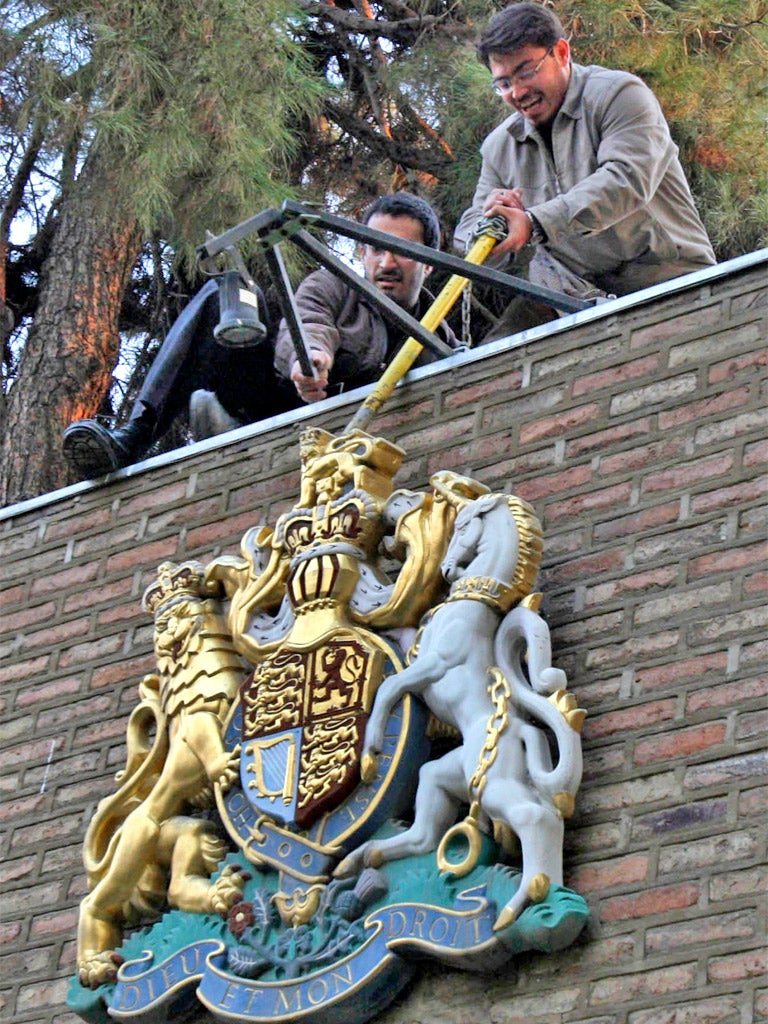Terrified staff flee as protesters storm British embassy in Tehran
William Hague 'outraged' at attack by hardliners who stole classified documents

Rising tensions between Britain and Iran burst into full-blown crisis yesterday when protesters stormed the UK embassy in Tehran, seizing classified documents and forcing staff to flee in panic.
About 50 students broke into the sprawling British compound in the city centre, smashed windows, ransacked offices and sprayed the walls with slogans including "Down with the UK" and "England Get Lost", according to Iranian news outlets.
Television footage showed bearded men scaling the embassy gates, where the British flag had been replaced with the Iranian standard. One man brandished a picture of the Queen, apparently seized from inside the embassy.
The attack came two days after Iran's parliament, the Majles, voted to expel Britain's ambassador, Dominick Chilcott, in retaliation for fresh British sanctions against Tehran's nuclear programme, which the West suspects is being used to create an atomic weapon.
The vote was accompanied by calls from several Iranian MPs to subject the British mission to a re-enactment of the 1979-81 takeover of the US embassy, when 53 American diplomats were held hostage for 444 days. There were conflicting accounts about the fate of staff. Most Iranian news outlets reported that they fled through a back door. However, one agency, Mehr, said some had been taken hostage but later removed the story from its website. According to Iranian and Western sources a group of men followed the demonstrators into the building, headed for specific locations and took documents. The files, identifying dissidents and opposition figures, are believed to have been seized by Iran's security police.
There is deep concern in London that Iranian human rights activists may now be vulnerable. Very little intelligence material was kept in either the embassy or residential complex because the security of the buildings could not be guaranteed, security officials claimed. However, there may have been some paperwork relating to people who had been in contact with the embassy at some point or other "for perfectly innocent reasons".
The Iranian foreign ministry last night expressed its regret over the attacks. However, Western diplomats are convinced that Monday's endorsement by the country's Guardian Council of a parliamentary vote to drastically cut diplomatic ties was seen as an official "green light" for the violence.
The semi-official Fars news agency reported that two cars inside the compound had been set ablaze and bottles of alcohol – outlawed under Iran's Islamic legal code – seized and smashed. Satellite dishes were said to have been destroyed as a protest against the BBC's Persian language television station, which broadcasts to Iran by satellite and has been condemned by Tehran as interference in its domestic affairs.
Demonstrators were seen holding portraits of the murdered Iranian nuclear scientists Majid Shahriari and Masoud Ali Mohammadi. Yesterday marked the first anniversary of Shahriari's assassination in a car bomb attack. Iran alleges he was killed by Israel's intelligence agency, Mossad.
A speaker outside the embassy told protesters that all hostile acts against Iran could be traced back to Britain. Eight Iranians working for the British embassy were arrested after the mass demonstrations against President Mahmoud Ahmadinejad disputed re-election in 2009. In a speech at the time, Iran's supreme leader, Ayatollah Ali Khamenei, accused Britain of orchestrating the upheavals and said it was the "most treacherous" of Iran's enemies. As news of the events unfolded, William Hague left the House of Commons and returned to the Foreign Office to head a crisis team. Soon afterwards the Iranian chargé d'affaires was summoned to convey the British Government's "outrage" at the attack. Britain is now considering withdrawing all its embassy personnel except a skeleton staff for essential services.
Noushin Hoseiny is a journalist with Radio Farda, the Persian language outlet of RFE/RL
History of violence: US embassy siege
On 4 November 1979, students and clerics occupied the US embassy in Tehran, demanding the return of the US-backed exiled Shah, Mohammad Reza Pahlavi, to Iran for trial. They held 52 hostages for 444 days in a siege that prompted President Jimmy Carter to send in commandos. The mission was aborted after eight soldiers died when a helicopter collided with a tanker aircraft. The mission's failure was highly damaging to President Carter; the hostages were finally freed in 1981, on the same day Ronald Reagan was inaugurated.
Join our commenting forum
Join thought-provoking conversations, follow other Independent readers and see their replies
Comments
Bookmark popover
Removed from bookmarks